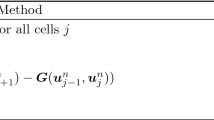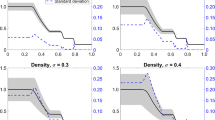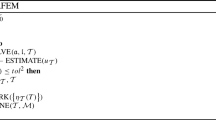Abstract
In this paper, a novel multiresolution framework, namely the Truncate and Encode (TE) approach, previously proposed by some of the authors (Abgrall et al. in J Comput Phys 257:19–56, 2014. doi:10.1016/j.jcp.2013.08.006), is generalized and extended for taking into account uncertainty in partial differential equations (PDEs). Innovative ingredients are given by an algorithm permitting to recover the multiresolution representation without requiring the fully resolved solution, the possibility to treat a whatever form of pdf and the use of high-order (even non-linear, i.e. data-dependent) reconstruction in the stochastic space. Moreover, the spatial-TE method is introduced, which is a weakly intrusive scheme for uncertainty quantification (UQ), that couples the physical and stochastic spaces by minimizing the computational cost for PDEs. The proposed scheme is particularly attractive when treating moving discontinuities (such as shock waves in compressible flows), even if they appear during the simulations as it is common in unsteady aerodynamics applications. The proposed method is very flexible since it can easily coupled with different deterministic schemes, even with high-resolution features. Flexibility and performances of the present method are demonstrated on various numerical test cases (algebraic functions and ordinary differential equations), including partial differential equations, both linear and non-linear, in presence of randomness. The efficiency of the proposed strategy for solving stochastic linear advection and Burgers equation is shown by comparison with some classical techniques for UQ, namely Monte Carlo or the non-intrusive polynomial chaos methods.




















Similar content being viewed by others
Notes
In the following the exposition is made for a scalar output variable (\(u\)) for brevity, but the extension to the multidimensional output case is straightforward.
References
Abgrall, R., Congedo, P.M.: A semi-intrusive deterministic approach to uncertainty quantifications in non-linear fluid flow problems. J. Comput. Phys. 235, 828–845 (2013)
Abgrall, R., Congedo, P.M., Corre, C., Galera, S.: A simple semi-intrusive method for uncertainty quantification of shocked flows, comparison with non-intrusive polynomial chaos method. In: Pereira, J.C.F., Sequeira, A., Pereira, J.M.C. (eds.) Proceedings of the V European Conference on Computational Fluid Dynamics ECCOMAS CFD 2010, Lisbon, Portugal, 14–17 June 2010
Abgrall, R., Congedo, P.M., Galéra, S., Geraci, G.: Semi-intrusive and non-intrusive stochastic methods for aerospace applications. In: 4th European Conference for Aerospace Sciences, Saint Petersburg, Russia, pp. 1–8 (2011)
Abgrall, R., Congedo, P.M., Geraci, G.: An adaptive multiresolution inspired scheme for solving the stochastic differential equations. In: Spitaleri (ed.) MASCOT11 11th Meeting on Applied Scientific Computing and Tools. Rome, Italy (2011)
Abgrall, R., Congedo, P.M., Geraci, G.: Toward a unified multiresolution scheme in the combined physical/stochastic space for stochastic differential equations. Tech. rep., INRIA (2012)
Abgrall, R., Congedo, P.M., Geraci, G.: A high-order adaptive semi-intrusive finite volume scheme for stochastic partial differential equations. In: MASCOT13 13th Meeting on Applied Scientific Computing and tools, San Lorenzo de El Escorial, Spain (2013)
Abgrall, R., Congedo, P.M., Geraci, G.: A high-order non-linear multiresolution scheme for stochastic PDEs. In: European Workshop on High Order Nonlinear Numerical Methods for Evolutionary PDEs: Theory and Applications (HONOM 2013) (2013)
Abgrall, R., Congedo, P.M., Geraci, G.: A one-time Truncate and Encode multiresolution stochastic framework. J. Comput. Phys. 257, 19–56 (2014). doi:10.1016/j.jcp.2013.08.006
Abgrall, R., Congedo, P.M., Geraci, G., Iaccarino, G.: Adaptive strategy in multiresolution framework for uncertainty quantification. In: Prooceedings of the Summer Program, Center For Turbulence Research, pp. 209–218 (2012). http://ctr.stanford.edu/Summer/SP12/index.html
Abgrall, R., Congedo, P.M., Geraci, G., Iaccarino, G.: An adaptive multiresolution semi-intrusive scheme for UQ in compressible fluid problems. Int. J. Numer. Methods Fluids (2015). doi:10.1002/fld.4030
Abgrall, R., Harten, A.: Multiresolution representation in unstructured meshes. SIAM J. Numer. Anal. 35(6), 2128–2146 (1998). doi:10.1137/S0036142997315056
Abgrall, R., Sonar, T.: On the use of Mühlbach expansions in the recovery step of ENO methods. Numerische Mathematik. 1–25 (1997). http://www.springerlink.com/index/LTXHR8P0MC3QBQA7.pdf
Amat, S., Aràndiga, F., Cohen, A., Donat, R.: Tensor product multiresolution analysis with error control for compact image representation. Signal Process. 82, 587–608 (2002). http://www.sciencedirect.com/science/article/pii/S0165168401002067
Amat, S., Busquier, S., Trillo, J.: Nonlinear Harten’s multiresolution on the quincunx pyramid. J. Comput. Appl. Math. 189(1–2), 555–567 (2006). doi:10.1016/j.cam.2005.03.034. http://linkinghub.elsevier.com/retrieve/pii/S0377042705001433
Aràndiga, F., Belda, A.M., Mulet, P.: Point-value WENO multiresolution applications to stable image compression. J. Sci. Comput. 43(2), 158–182 (2010). doi:10.1007/s10915-010-9351-8
Arandiga, F., Chiavassa, G., Donat, R.: Harten framework for multiresolution with applications: from conservation laws to image compression. Boletín SEMA 31(31), 73–108 (2009). http://www.sema.org.es/ojs/index.php?journal=sema&page=article&op=view&path[]=174
Arandiga, F., Donat, R.: Nonlinear multiscale decompositions: the approach of A. Harten. Numer. Algorithms 23, 175–216 (2000). http://www.springerlink.com/index/N363R0747675J70L.pdf
Babuška, I., Nobile, F., Tempone, R.: A stochastic collocation method for elliptic partial differential equations with random input data. SIAM Rev. 52(2), 317 (2010). doi:10.1137/100786356. http://link.aip.org/link/SIREAD/v52/i2/p317/s1&Agg=doi
Bellman, R.E., Richard, B.: Adaptive Control Processes: A Guided Tour. Princeton University Press (1961). http://books.google.com/books?id=POAmAAAAMAAJ&pgis=1
Bihari, B.L., Harten, A.: Multiresolution schemes for the numerical solution of 2-D conservation laws I. SIAM J. Sci. Comput. 18(2), 315 (1997). doi:10.1137/S1064827594278848. http://link.aip.org/link/SJOCE3/v18/i2/p315/s1&Agg=doi
Chiavassa, G., Donat, R.: Point value multiscale algorithms for 2D compressible flows. SIAM J. Sci. Comput. 23(3), 805–823 (2001). http://epubs.siam.org/doi/abs/10.1137/S1064827599363988
Cohen, A., Dyn, N., Matei, B.: Quasilinear subdivision schemes with applications to ENO interpolation. Appl. Comput. Harmon. Anal. 15, 89–116 (2003). http://www.sciencedirect.com/science/article/pii/S1063520303000617
Congedo, P.M., Geraci, G., Abgrall, R.: Semi-intrusive multi-resolution methods for stochastic compressible flows. In: VKI Lecture Series on ‘Uncertainty Quantification in Computational Fluid Dynamics’ (STO-AVT-235), Von Karman Institute For Fluid Dynamics (2014)
Geraci, G.: Schemes and Strategies to Propagate and Analyze Uncertainties in Computational Fluid Dynamics Applications. Ph.D. thesis, INRIA and University of Bordeaux 1 (2013)
Getreuer, P., Meyer, F.G.: ENO multiresolutions schemes with general discretizations. SIAM J. Numer. Anal. 46(6), 2953–2977 (2008). http://epubs.siam.org/doi/pdf/10.1137/060663763
Ghanem, R.G., Spanos, P.D.: Stochastic Finite Elements. A Spectral Approach. Springer, Berlin (1991)
Graham, I., Kuo, F., Nuyens, D., Scheichl, R., Sloan, I.: Quasi-Monte Carlo methods for elliptic PDEs with random coefficients and applications. J. Comput. Phys. 230(10), 3668–3694 (2011). doi:10.1016/j.jcp.2011.01.023. http://linkinghub.elsevier.com/retrieve/pii/S0021999111000489
Harten, A.: Discrete multi-resolution analysis and generalized wavelets. Appl. Numer. Math. 12(13), 153–192 (1993). doi:10.1016/0168-9274(93)90117-A
Harten, A.: Adaptive multiresolution schemes for shock computations. J. Comput. Phys. 135(2), 260–278 (1994). doi:10.1006/jcph.1997.5713. http://linkinghub.elsevier.com/retrieve/pii/S0021999197957132 http://www.sciencedirect.com/science/article/pii/S0021999184711995
Harten, A.: Multiresolution algorithms for the numerical solution of hyperbolic conservation laws. Commun. Pure Appl. Math. 48(12), 1305–1342 (1995). doi:10.1002/cpa.3160481201/abstract
Harten, A.: Multiresolution representation of data: a general framework. SIAM J. Numer. Anal. 33(3), 1205–1256 (1996)
Harten, A., Engquist, B., Osher, S.: Uniformly high order accurate essentially non-oscillatory schemes. III. J. Comput. Phys. 71(2), 231–303 (1987). doi:10.1016/0021-9991(87)90031-3
Le Maître, O., Knio, O.: Spectral Methods for Uncertainty Quantification: With Applications to Computational Fluid Dynamics. Springer, Berlin (2010)
Leveque, R.J.: Finite Volume Methods for Conservation Laws and Hyperbolic Systems. Cambridge University Press, Cambridge (2002)
Orszag, S.: Dynamical properties of truncated Wiener-Hermite expansions. Phys. Fluids 10(12), 2603–2613 (1967)
Quarteroni, A., Sacco, R., Saleri, F.: Numerical Mathematics. Springer, Berlin (2000)
Shu, C.: Essentially non-oscillatory and weighted essentially non-oscillatory schemes for hyperbolic conservation laws. Tech. Rep. 97, ICASE Report No. 97–65 (1997). http://link.springer.com/chapter/10.1007/BFb0096355
Toro, E.F.: Riemann Solvers and Numerical Methods for Fluid Mechanics. Springer, Berlin (1997)
Tryoen, J.: Methodes de Galerkin stochastiques adaptatives pour la propagation d’incertitudes parametriques dans les systemes hyperboliques. Ph.D. thesis, Université Paris-Est (2011)
Tryoen, J., Le Maître, O., Ern, A.: Adaptive anisotropic spectral stochastic methods for uncertain scalar conservation laws. SIAM J. Sci. Comput. 34, A2459–A2481 (2012)
Tryoen, J., Le Maître, O., Ndjinga, M., Ern, A.: Intrusive Galerkin methods with upwinding for uncertain nonlinear hyperbolic systems. J. Comput. Phys. 229, 6485–6511 (2010). doi:10.1016/j.jcp.2010.05.007
Wan, X., Karniadakis, G.E.: Beyond Wiener Askey expansions: handling arbitrary PDFs. J. Sci. Comput. 27(1–3), 455–464 (2005). doi:10.1007/s10915-005-9038-8
Xiu, D., Karniadakis, G.E.: Modeling uncertainty in flow simulations via generalized polynomial chaos. J. Comput. Phys. 187(1), 137–167 (2003). doi:10.1016/S0021-9991(03)00092-5
Acknowledgments
R. Abgrall and G. Geraci have been supported by the ERC Advanced Grant ADDECCO N. 226316, partially and fully respectively. Moreover, part of the present work has been conceived during the participation of P.M. Congedo and G. Geraci at the 25th Summer Program 2012 of the Center for Turbulence Research at the Stanford University thanks to the financial support of the Associated Team Aquarius (Inria-Stanford). PM Congedo and G. Geraci are also grateful to Jeroen Witteveen for the very interesting discussions on the adaptive strategies for discontinuous problems in UQ.
Author information
Authors and Affiliations
Corresponding author
Appendix: The High-Order MUSCL Hancock Method (MHM)
Appendix: The High-Order MUSCL Hancock Method (MHM)
In this section the MUSCL Hancock Method (MHM) is briefly recalled. A very interesting and exhaustive presentation of this method could be found in [38].
Let us consider a 1D scalar conservation law
where \(x \in \varOmega \subset {\fancyscript{R}}\) is the physical space and \(t \in T \subset {\fancyscript{R}}^+\) is the time space. In the context of finite volume scheme the physical space is divided in a set of non-overlapping cells \({{\fancyscript{C}}}_i\) with \(\varOmega = \bigcup _i {{\fancyscript{C}}}_i\). The classical first order Godunov scheme, applied to (46), is obtained introducing the so-called cell-average \(\bar{u}_i\) on each cell \({{\fancyscript{C}}}_i\):
where \(|{{\fancyscript{C}}}_i|\) indicated the volume of the cell.
After the integration on each cell \({{\fancyscript{C}}}_i\), it can be written
with \({\fancyscript{C}}_i = [ x_{i_L}, x_{i_R} ]\) and where \(x_{i_L}\) and \(x_{i_R}\) indicate the left and right interfaces.
Integrating in time the Eq. (48) between \(t_n\) and \(t_{n+1} = t_n +\varDelta t\), it follows that
where a numerical approximation for the flux along the interface \(x_{i_L}\) (and \(x_{i_R}\)) holds
The final form for the first order Godunov scheme is
As pointed out by LeVeque in [34] for hyperbolic problem, the information propagates with finite speed and it is reasonable to suppose that each numerical flux, at the interface, is function of the solution on the two cells to which it belongs: \(F_{i_L}^n = F_{i_L}^n(\bar{u}_{i-1}^n,\bar{u}_{i}^n)\) and \(F_{i_R}^n = F_{i_R}^n(\bar{u}_{i}^n,\bar{u}_{i+1}^n)\).
In this work, an exact Riemann solver is used to compute the numerical flux. In particular, given two constant states \(\bar{u}_{i-1}^n\) and \(\bar{u}_{i}^n\) separated by the interface, the exact solution of the problem, the so-called Riemann problem, can be found and the solution at the interface computed. The numerical flux is then equal to the flux function evaluated by knowing the exact solution at the interface. In the following, the numerical flux function obtained via the solution of the exact Riemann problem is indicated as \(F_{i_L}^n = {\fancyscript{F}}^{\mathrm {RM}}(u_{i-1}^n, u_{i}^n)\) for the left interface or \(F_{i_R}^n = {\fancyscript{F}}^{\mathrm {RM}}(u_{i}^n, u_{i+1}^n)\) for the right interface.
The first order Godunov scheme introduces a great amount of numerical diffusion and then van Leer [34, 38] proposed to consider non constant data on each cell to achieve a higher accuracy. From this idea, the so-called Monotone Upstream-centred Scheme for Conservation Laws (MUSCL) has been proposed. In this work, a piecewise linear approximation is used for the solution \(u(x,t)\) on the cell \(|{\fancyscript{C}}_i|\):
in which \(\sigma _i^n\) is the slope. The choice of \(\sigma _i^n=0\) lead to the Godunov scheme. Computing the slope \(\sigma _i^n\) as a function of only the cell averaged solution in the neighboring cells, i.e. \(\sigma _i^n = \sigma _i^n(\bar{u}_{i-1}^n, \bar{u}_{i+1}^n)\), is not the best choice. If centered slope are used, spurious oscillations can be introduced in discontinuous solution. In practice, a slope limiter should be introduced near the discontinuity to avoid oscillations. In this work the Roe’s superbee limiter is employed in which
where the \(\mathrm {minmod}\) and \(\mathrm {maxmod}\) are defined as follows
The fully discrete second order MHM, to compute the cell averaged solution \(\bar{u}_i^{n+1}\), consists of the following three steps:
-
For each cell \({\fancyscript{C}}_{\ell } \in \left\{ {\fancyscript{C}}_{i-1}, {\fancyscript{C}}_{i}, {\fancyscript{C}}_{i+1}\right\} \) the solution at the interface is computed according to
$$\begin{aligned} \left\{ \begin{array}{ll} u_{\ell _L}^n &{}= \bar{u}_{\ell }^n - \sigma _{\ell }^n \frac{|{\fancyscript{C}}_{\ell }|}{2} \\ u_{\ell _R}^n &{}= \bar{u}_{\ell }^n + \sigma _{\ell }^n \frac{|{\fancyscript{C}}_{\ell }|}{2} \\ \end{array} \right. \end{aligned}$$(55) -
On each cell \({\fancyscript{C}}_\ell \in \left\{ {\fancyscript{C}}_{i-1}, {\fancyscript{C}}_{i}, {\fancyscript{C}}_{i+1} \right\} \) the solution is evolved using an half time step:
$$\begin{aligned} \left\{ \begin{array}{ll} u_{\ell _R}^{\Uparrow } &{}= u_{\ell _R}^n + \frac{1}{2} \frac{\varDelta t}{|{\fancyscript{C}}_{\ell }|} \left( f(u_{{\ell }_L}^n) - f(u_{{\ell }_R}^n) \right) \\ u_{{\ell }_L}^{\Uparrow } &{}= u_{\ell _L}^n + \frac{1}{2} \frac{\varDelta t}{|{\fancyscript{C}}_{\ell }|} \left( f(u_{{\ell }_L}^n) - f(u_{{\ell }_R}^n) \right) \\ \end{array} \right. \end{aligned}$$(56) -
The cell averaged value on the cell \({\fancyscript{C}}_i\) is evolved following
$$\begin{aligned} \bar{u}_{i}^{n+1} = \bar{u}_{i}^{n} - \frac{\varDelta t}{|{\fancyscript{C}}_i|} \left( {\fancyscript{F}}^{\mathrm {RM}}\left( u_{{i-1}_R}^{\Uparrow }, u_{i_L}^{\Uparrow } \right) - {\fancyscript{F}}^{\mathrm {RM}}\left( u_{i_R}^{\Uparrow }, u_{{i+1}_L}^{\Uparrow }\right) \right) . \end{aligned}$$(57)
The time advancing formula is then limited to a stencil of only three cells \({\fancyscript{C}}_{i-1}\), \({\fancyscript{C}}_{i}\) and \({\fancyscript{C}}_{i+1}\), but the computation of the slopes for the cells \({\fancyscript{C}}_{i-1}\) and \({\fancyscript{C}}_{i+1}\) requires (see (53)) also to know the solution on the two sourrounding cells \({\fancyscript{C}}_{i-2}\) and \({\fancyscript{C}}_{i+2}\). The average solution \(\bar{u}_{i}^{n+1}\), on each cell \({\fancyscript{C}}_i\) at time \(t_{n+1} = t_n + \varDelta t\), can be computed knowing the solution on the augmented stencil, the \( \mathrm {PV} \) introduced in Sect. 4, \(\left\{ \bar{u}_{i-2}^n, \bar{u}_{i-1}^n, \bar{u}_{i}^n, \bar{u}_{i+1}^n, \bar{u}_{i+2}^n \right\} \) which constitutes the stencil obtained via the physical assembling algorithm (see Algorithm 3).
Rights and permissions
About this article
Cite this article
Geraci, G., Congedo, P.M., Abgrall, R. et al. A Novel Weakly-Intrusive Non-linear Multiresolution Framework for Uncertainty Quantification in Hyperbolic Partial Differential Equations. J Sci Comput 66, 358–405 (2016). https://doi.org/10.1007/s10915-015-0026-3
Received:
Revised:
Accepted:
Published:
Issue Date:
DOI: https://doi.org/10.1007/s10915-015-0026-3




